*This post may contain affiliate links. Read more »
Chana Dal, also known as "Bengal Gram," derives its name from the Hindi language. "Chana" refers to chickpeas, while "Dal" in this context means legume preparation. This timeless dish traces its roots to the lush lands of Bengal, a region in eastern India, renowned for its rich agricultural heritage and culinary artistry.
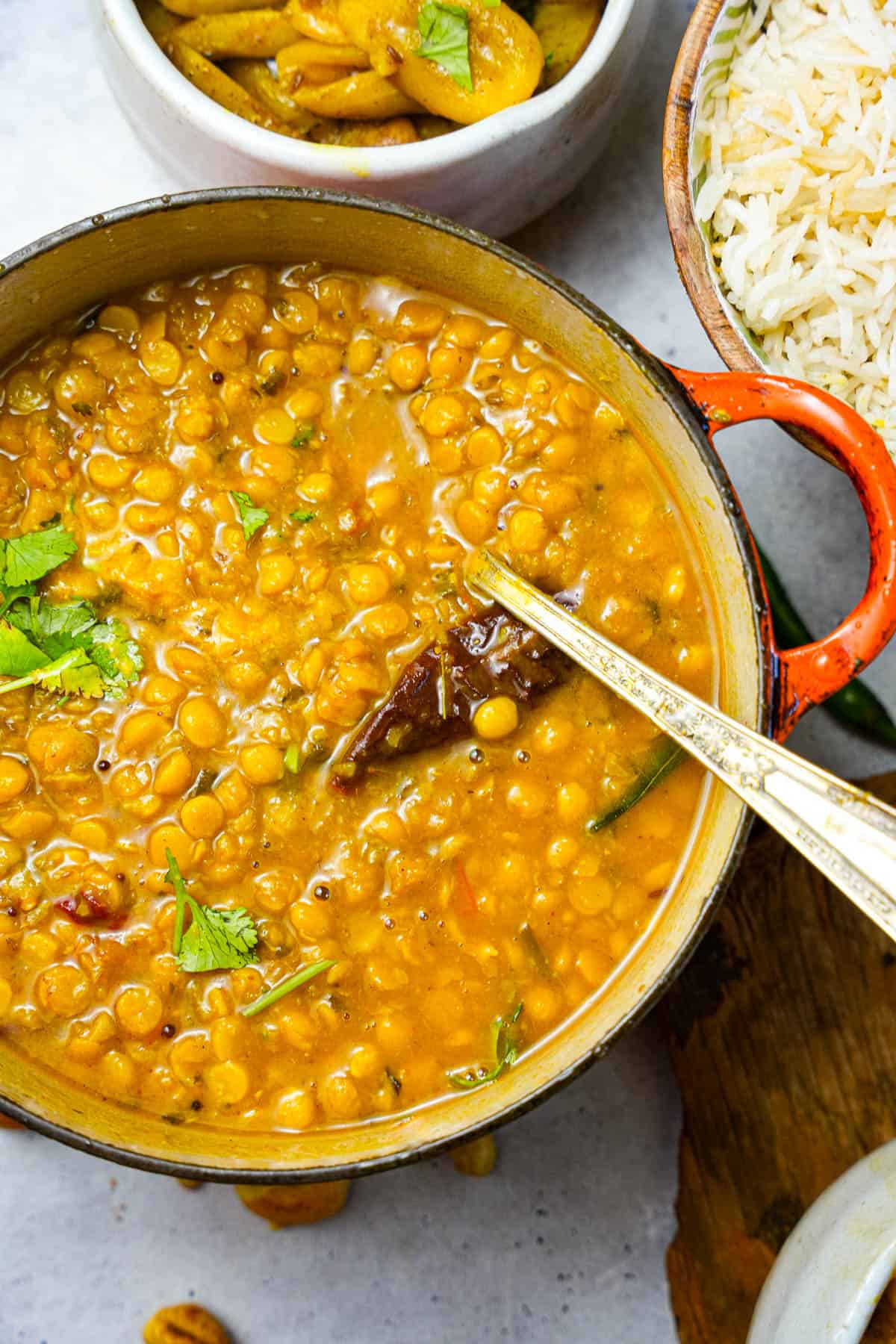

Enter your email & I'll send it to your inbox. Plus, get great new recipes from me every week!
By submitting this form, you consent to receive emails from Cinnamon Snail.
In the heart of rustic Indian cuisine, Chana Dal is cherished for its robust flavors and filling nutritional benefits. Bursting with plant-based protein, this vegan delicacy exemplifies the simplicity of classic Indian recipes with outstanding complex flavors. A bowl of warm chana dal over biryani or coconut rice, served with some pickled green chilies, or some warm, freshly baked aloo kulcha, or parotta and you are in Bangali comfort food heaven.
Whether you adhere to a sattvic, vegan, or gluten-free diet, this traditional Bengal Gram curry will get your dinner on the table quickly, and leave you super satisfied. Happy cooking!
Jump to:
- 🥰Why you'll adore this split chickpeas recipe
- 💪 Health Benefits of Chana Dal
- 🌶️ What's in this sattvic style chana dal
- 📖 How to make chana dal without onion garlic
- 🍽️Serving Ideas
- Understanding Sattvic Food and the Significance of Prasadam:
- 👉Top tips
- 🤷♀️Recipe FAQs
- ✌️My favey dishes to serve with this recipe:
- Chana Dal (Sattvic vegan Bengal Gram curry)
🥰Why you'll adore this split chickpeas recipe
✊Vegan, Gluten-Free AND Sattvic! This chana dal recipe contains no animal-based ingredients, gluten, onions, or garlic. Long story short, this makes this dal perfect for everyone, including as bhoga for the Supreme!
👨🍳Easy enough for my dad to make blindfolded: Chana dal comes together in a snap, and you don’t need to be a super confident cook to have great results with it. It also doesn’t require a whole lot of prep or cleanup. M’dad isn’t into all of that, so he approves of this recipe.
✅Tested and Approved Worldwide: Like every recipe on my blog, this chana dal recipe has been tried, tested, and loved by a group of dedicated recipe testers from all over the world.


Curry in a Hurry - Vegan Indian Recipe Club! 🍲💌
This 6-day program is 100% FREE. Let me help you to master plant-based Indian cooking!
💪 Health Benefits of Chana Dal
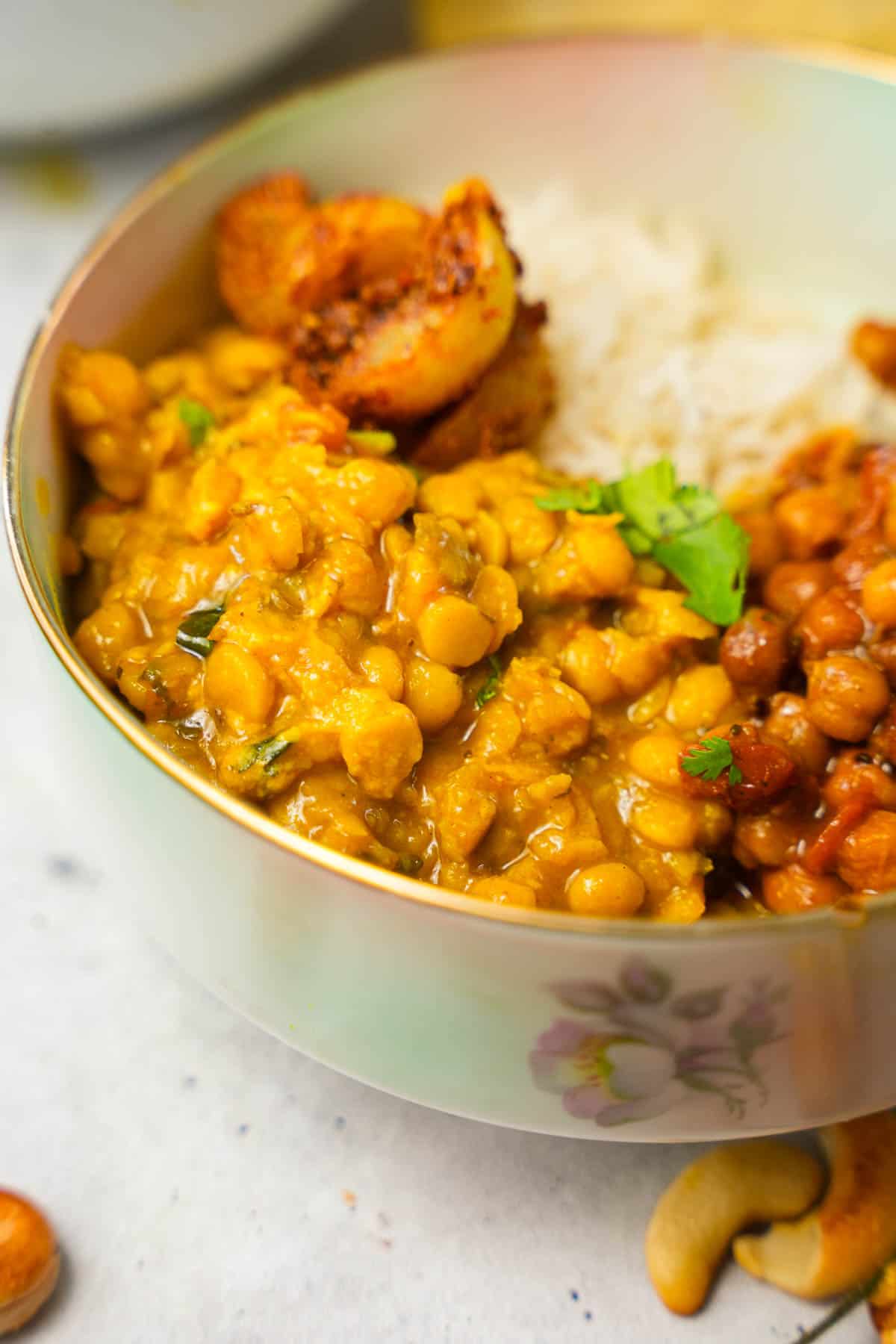
Chana Dal offers a myriad of health benefits, making it a nutritious addition to any diet. Here are some of the health perks this wholesome legume brings to the table:
High Protein: Chana dal is a significant source of plant-based protein. Protein is essential for cell repair, muscle development, and overall body function.
Fiber-Rich: With its high fiber content, chana dal promotes healthy digestion, aids in weight management, and helps regulate blood sugar levels. The soluble fiber in chana dal also supports heart health by reducing cholesterol levels.
Essential Minerals: Bengal gram is a rich source of essential minerals like iron, magnesium, phosphorus, and potassium. These minerals contribute to maintaining healthy bones, supporting nerve function, and regulating blood pressure.
Low-Glycemic Food: Sadly, with the rise in sugary processed food, diabetes is a health issue that has become rampant in India, and worldwide. But adopting a natural plant-based diet can help with that! Chana dal has a low glycemic index, meaning it causes a gradual rise in blood sugar levels, making it suitable for individuals with diabetes or those aiming to manage blood sugar levels.
Vitamin Powerhouse: This dal is packed with essential vitamins, including vitamin B-complex (B1, B3, B6), which aid in energy production, cognitive function, and maintaining healthy skin, hair, and nails.
Antioxidant Properties: Chana dal contains antioxidants that help combat harmful free radicals, reducing oxidative stress and promoting overall cellular health.
Sattvic and Ayurvedic Benefits: In Ayurveda, Chana Dal prepared without onions or garlic, or any unfresh ingredients, is considered sattvic, offering a balanced and calming effect on the mind and body. It is believed to enhance vitality, promote tranquility, and support a balanced lifestyle.
🌶️ What's in this sattvic style chana dal
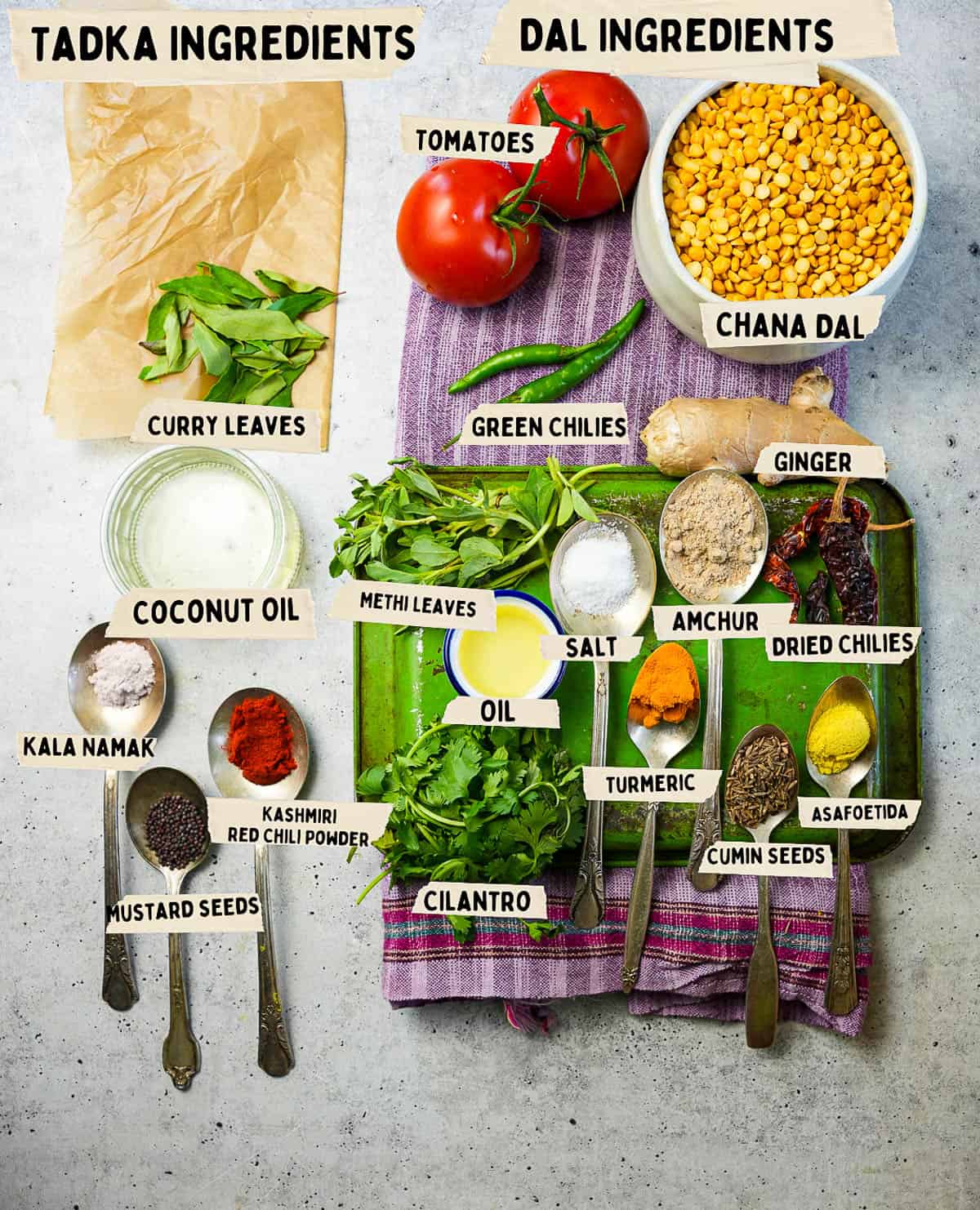
Bengal gram dal
Chana Dal, also known as Bengal Gram lentils, are small, split chickpeas commonly used in Indian cuisine. They are a rich source of plant-based protein, fiber, and essential minerals, making them a nutritious addition to the diet. If you don't have chana dal on hand, you can use yellow split peas as a replacement.
Red lentils are better off saved for making masoor dal or Lebanese lentil soup.
Byadagi Chilies
Byadagi chilies hail from the Karnataka region of India, where I spent almost every winter in Mysore. These mildly spicy red chilies are known for their subtle smokiness and mild heat. They are fantastic in Peerkangai Kootu and Aviyal. If Byadagi chilies are hard to find, you can use generic dried red Indian chilies, dried guajillo peppers, or chili arbol, which are a bit spicier.
Amchur
Amchur is a tangy spice made from dried unripe green mangoes. Mango powder brings a delightful sourness to the curry, and also adds acidity without liquid to things that need to stay crispy, duch as phool makhana. Besides its citrusy flavor, the acidity in amchur also acts as a natural tenderizer for the chana dal, ensuring a soft and well-cooked texture. If you can't find amchur, you can use a little lemon juice or tamarind concentrate in its place.
Kala Namak
Kala Namak, also known as Himalayan Black Salt, originates from the Indian subcontinent. Despite its name, it is pinkish-gray in color and carries a distinctive eggy flavor. If Kala Namak is unavailable, regular table salt can be used, though it won't replicate the specific funky flavor.
Kashmiri Chili Powder
Kashmiri red chili powder is famous for its brilliant red color and moderate heat. Unlike regular chili powders, it imparts vibrant color without overwhelming spiciness, which is why it's just perfect in pickles like gajar ka achar,. If you can’t get your hands on Indian red chilli powder, use a mixture of paprika and cayenne pepper in its place.
*See the recipe card at the bottom of the page for exact quantities, nutritional info, and detailed cooking directions.
📖 How to make chana dal without onion garlic
Put on your rain jacket, and let’s hose ya down with the steps for perfectly cooked Chana Dal… Or you can follow along with the easy-to-print recipe card towards the bottom of this page.

Step 1
Give the chana dal a thorough rinse under cool, running water until the water runs clear. This helps remove any debris or impurities and ensures the dal cooks nicely.
Step 2
In a large pot, heat the oil over medium-high heat.
Step 3
Once the oil is hot, add the diced tomatoes, grated ginger, chopped green chilies, cumin seeds, the dried red chilies, and sprinkle the coriander powder, asafetida, turmeric, and amchur. Stir-fry this aromatic mix for 3-4 minutes, letting the tomatoes soften and the spices release their fragrance.
Step 4
Add the rinsed chana dal, kasuri methi, chopped cilantro, and water to the pot. Bring the mixture to a gentle boil, covered over medium heat.
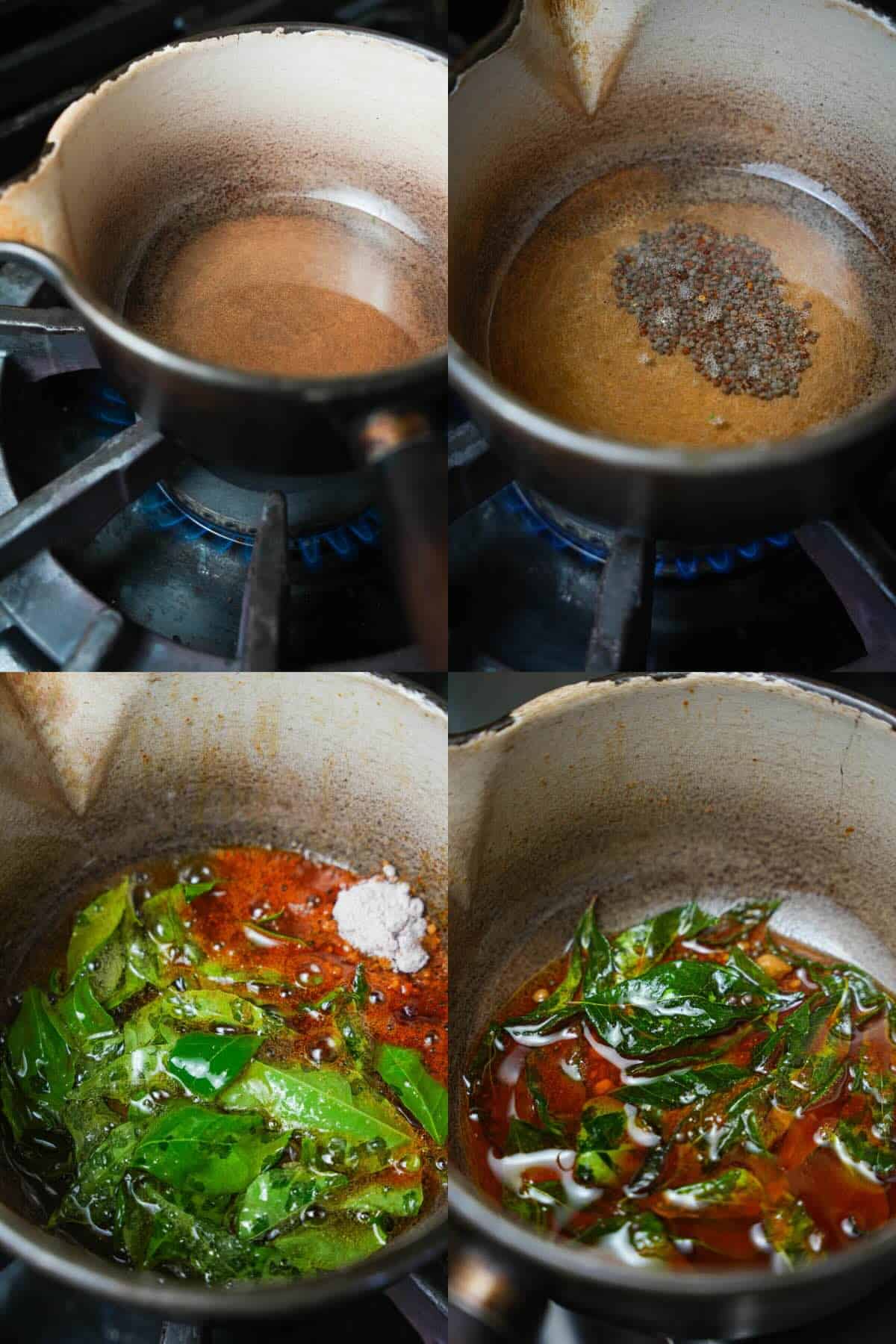
Step 5
While the chana dal simmers, in a separate small pan, heat the coconut oil over medium heat.
Step 6
After about 60 seconds when the oil is hot, add the mustard seeds.
Step 7
After the mustard seeds start to pop and sputter, lower the heat and add the Kashmiri red chili powder, curry leaves, and a sprinkle of kala namak (black salt) to the pan. Stir-fry the tadka for about a minute.
Step 8
Turn off the heat and set the tadka aside.
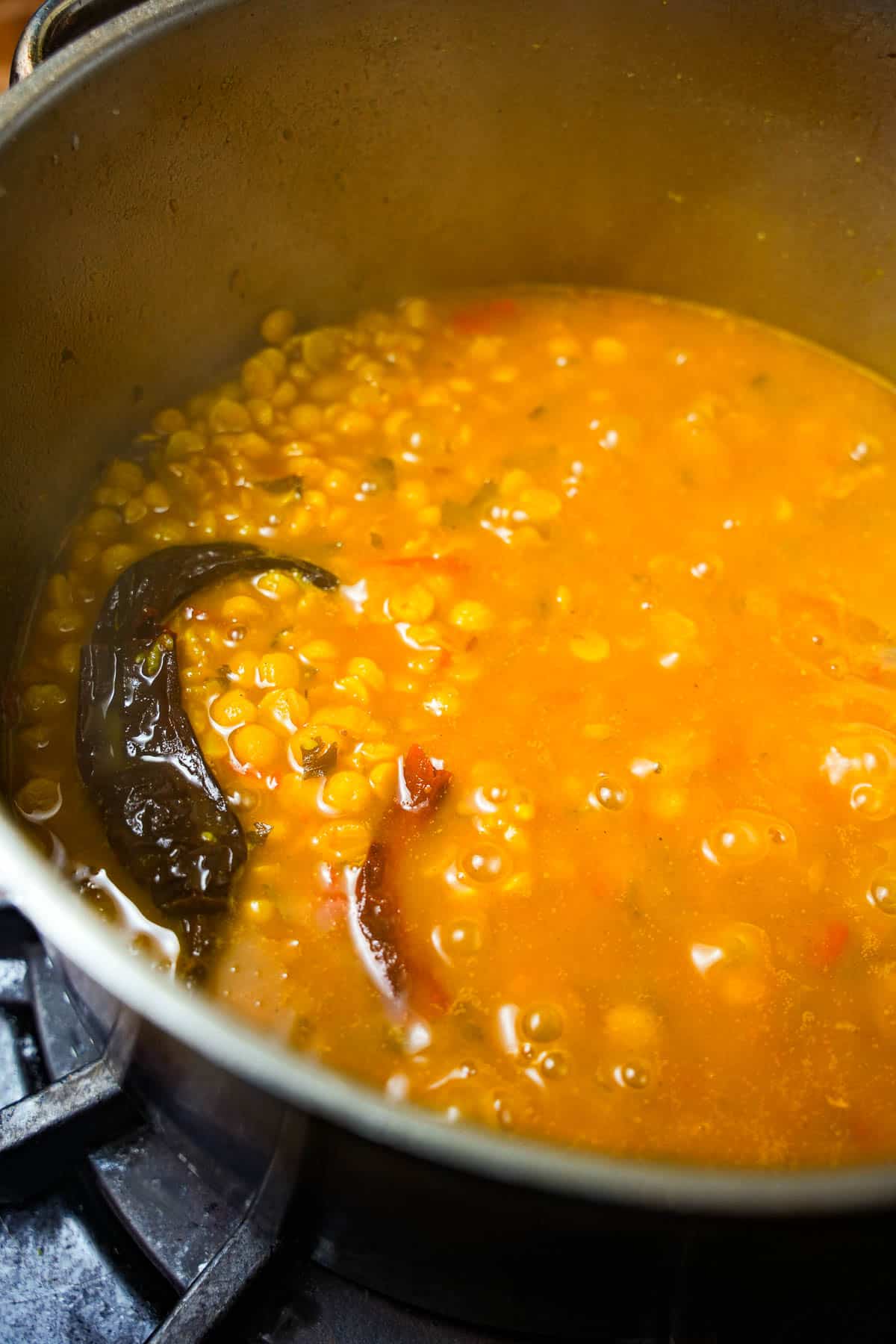
Step 9
After the chana dal has been cooking for around 30 minutes, it's time to check for doneness. Add salt to the dal, adjusting the amount to your taste preferences. Continue cooking for another 15-20 minutes, or until the dal becomes tender, but not totally mushy. If you prefer, you can cook it in an instant pot or stove top pressure cooker to reduce the cooking time.
➡️ If you prefer a thinner consistency, add a bit more water to the dal at this stage, until it reaches your desired thickness.
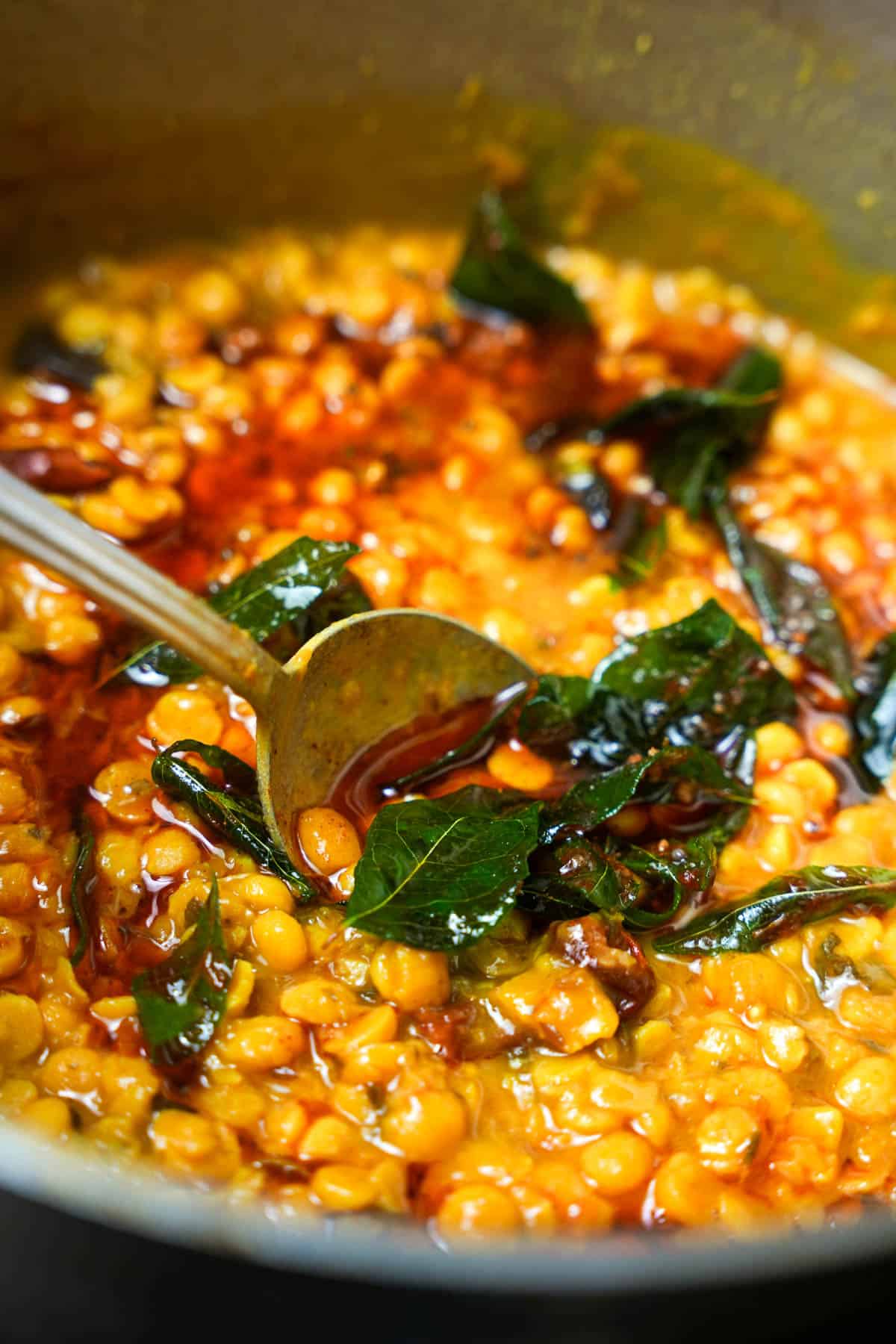
Step 10
Once the chana dal is cooked to perfection, pour the prepared tadka over it. Gently stir the dal and tadka together.
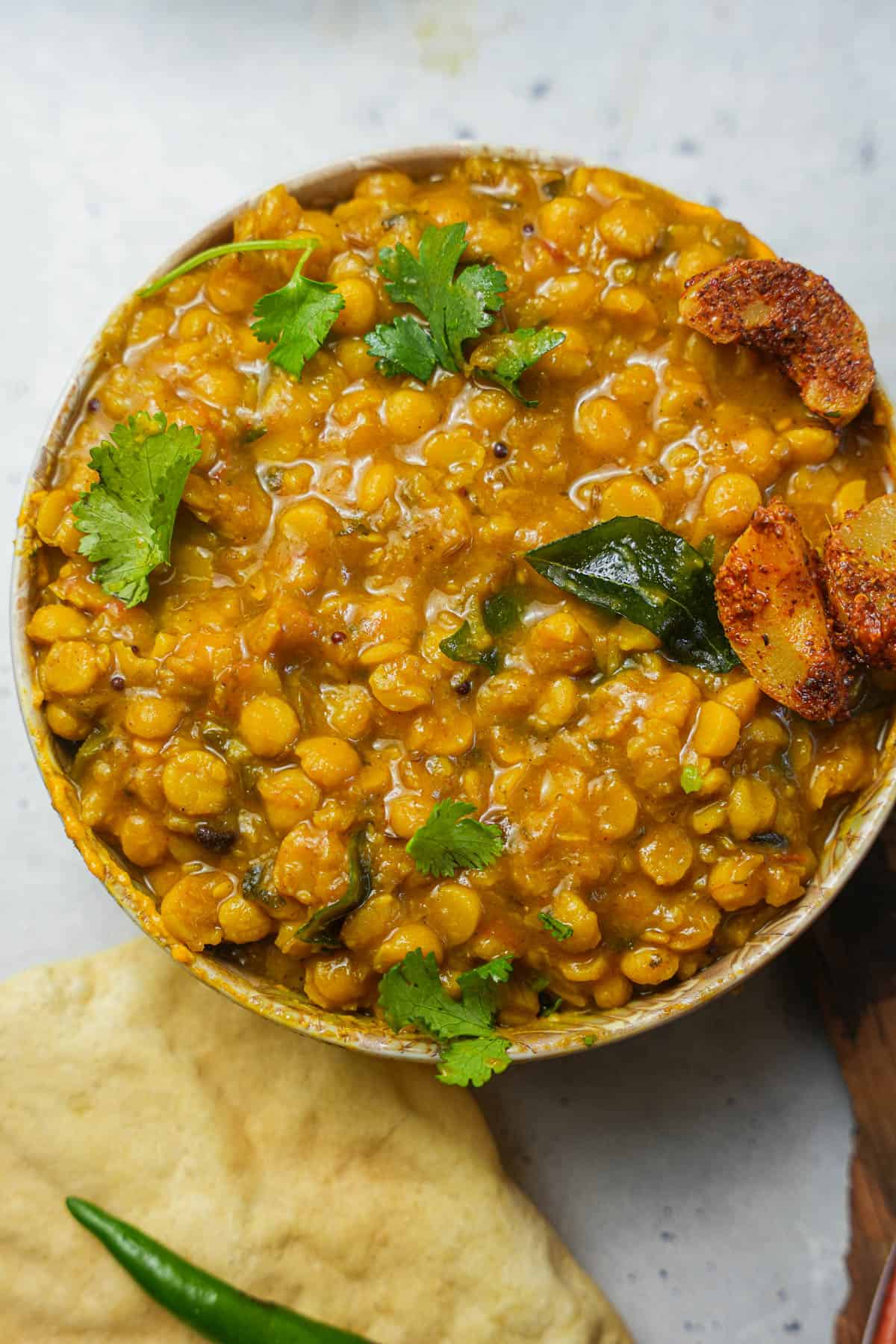
Step 11
Garnish with fresh cilantro leaves and, if you desire a hint of extra heat, adorn with thinly sliced red or green chilies. Serve it over rice with a side of mango pickle, or amla pickle aid in digestion.
🍽️Serving Ideas
Chana Dal, with its wholesome and hearty flavors, pairs exquisitely with a variety of dishes, creating a satisfying and easy-to-prepare meal. Here are some serving suggestions to elevate this humble dal:
- Rice or grains: Aromatic basmati pilau, or turmeric rice serve as a perfect bed for the Chana Dal curry. Dal and grains combine nutritionally to provide complete plant-based protein. If you aren’t into rice, another great option is to serve the dal over cracked wheat pilaf.
- Subzis (Vegetable Dishes): Turn the dal into a component of a complete thali with an assortment of subzis like olan, lauki ki sabji, Punjabi dry bhindi, kala chana, vegan butter chicken (made with my realistic plant-based chicken), or saag aloo. Do people think Indian food is too carb heavy? They probably haven’t explored all these great veg. preps, and should go to vegetable jail!
- Chaats: For a more casual meal, serve Chana Dal alongside chaats like shakarkandi chaat, kanda bhaji, or medhu vada. The delightful savory and crunchy chaats contrast perfectly with the creamy dal.

Understanding Sattvic Food and the Significance of Prasadam:
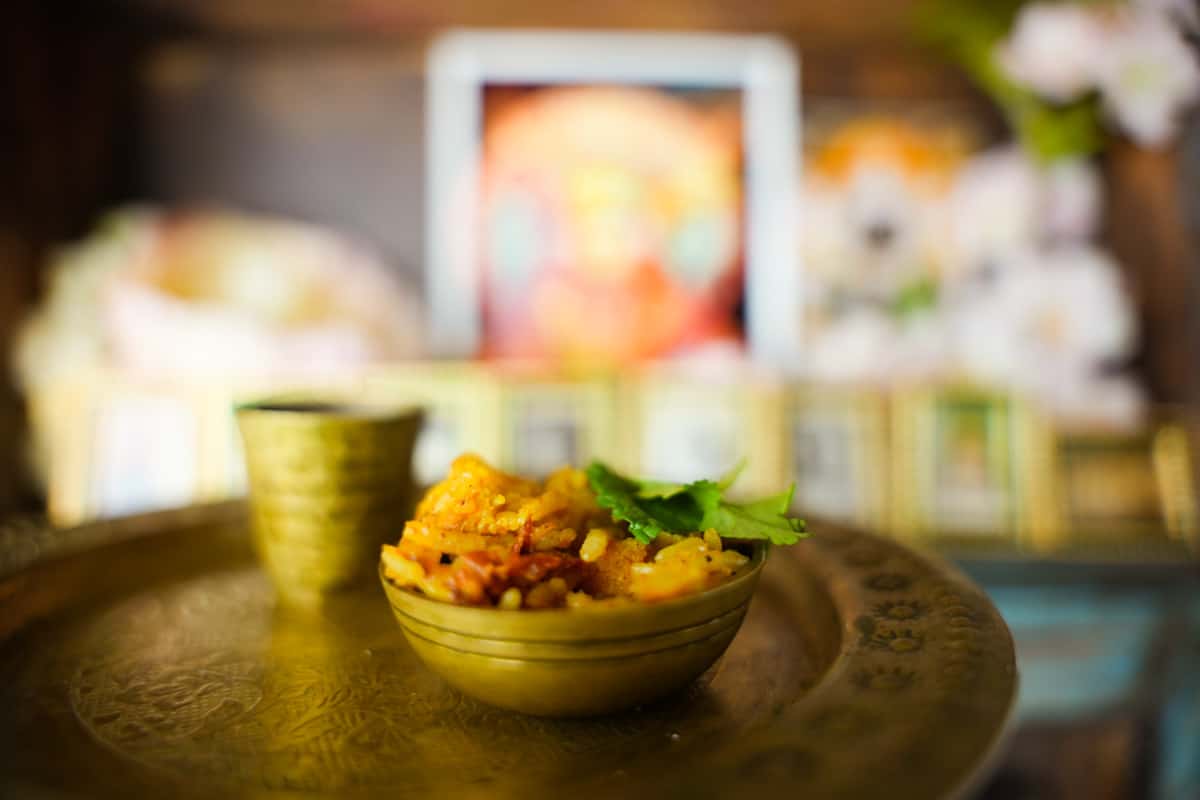
Sattvic Food: Sattvic food is an integral aspect of Ayurvedic and yogic practices, promoting harmony, and decreasing the senses' attraction to the material modes of tamas and rajas (ignorance/darkness, and passion/bewilderment). This ancient lifestyle concept revolves around consuming foods that are pure, fresh, and suitable as offering to the Supreme. Sattvic foods are believed to nurture a tranquil state of mind, enhance clarity, and foster spiritual growth. Such foods are naturally wholesome, easy to digest, and plant-based. Herbs and spices that promote balance and calmness, like turmeric and cardamom, are also commonly used in sattvic cuisine, and ingredients that can disturb the body, mind, and senses are avoided.
The Significance of Prasadam: In the context of devotion and spirituality, prasadam holds profound significance for followers of various spiritual traditions. In our tradition, the Brahmā-Madhva-Gauḍīya-sampradāya, prasadam refers to food or offerings (including physical or mental offerings) sanctified by deities during religious ceremonies or rituals. When devotees partake in prasadam, it is believed to be the spiritualized remnants of the Supreme, elevating it beyond ordinary food. Prasadam is to be offered with pure intentions, symbolizing surrender and gratitude to the divine, reinforcing the bond between the devotee and the higher power.
The act of sharing prasadam with others further emphasizes a sense of unity, compassion, and communal harmony among devotees. For me, the most inspiring account of prasadam distribution between Narada Muni and Lord Siva is narrated in Locana Dasa Thankur's Caitanya Mangala. By honoring prasadam, devotees embrace humility, selflessness, and reverence, transcending the mere physical aspects of food to embrace a profound spiritual experience.
👉Top tips
Soaking lentils: Soaking the chana dal overnight before rinsing and cooking is a valuable tip to enhance both the texture and flavor, while decreasing the cooking time.
Experiment with Spices: Don't be afraid to experiment with various spices and herbs to personalize the flavor of your dal. If you don't follow a sattvic diet, feel free to add ginger garlic paste to the tadka or dal itself. Garam masala is an easy way to add more warming spices to the dal.
Mindful Stirring: When cooking dal, stir it occasionally to prevent sticking or burning at the bottom of the pot.
🤷♀️Recipe FAQs
Chana dal and yellow split peas are both legumes, but they come from different plants and have distinct characteristics:
Chana dal, also known as split Bengal gram dal, is made from split and skinned chickpeas (Cicer arietinum), commonly found in the Indian subcontinent. On the other hand, yellow split peas are derived from the seeds of the field pea (Pisum sativum), and they are popular in North America and some European cuisines.
Chana dal is relatively small and flat compared to yellow split peas, which are rounder and slightly larger.
Chana dal tends to cook faster than yellow split peas. Due to its smaller size, chana dal typically takes about 25 to 30 minutes to cook, whereas yellow split peas may require around 40 to 45 minutes.
Chana dal is known for its higher protein content and also provides a good amount of folate, iron, and magnesium.
Storing and reheating channa dal is no prob. Just expect that it will stiffen up a bit once chilled, and will need a little extra water stirred in to bring it back to the desired consistency.
✌️See ya later, ‘frigerator
After preparing the Chana Dal, allow it to cool to room temperature. Transfer the leftover curry to an airtight container. Refrigerate the Chana Dal within two hours of cooking to maintain its freshness. It can be kept in the refrigerator for up to four days.
🔥Stovetop reheating
1. Transfer the desired portion of Chana Dal from the refrigerator or freezer to a saucepan.
2. Add extra water to the dal to prevent sticking, and to thin it to the desired consistency.
3. Heat the Chana Dal over medium heat, stirring occasionally to ensure even reheating.
☢️Microwave Reheating
1. For refrigerated Chana Dal, transfer the desired portion to a microwave-safe glass bowl.
2. Stir in water to thin the dal.
3. Cover the bowl with a microwave-safe plate or microwave-safe lid.
4. Heat the Chana Dal in the microwave on medium power for 2-3 minutes, stirring halfway through.
For longer-term storage, you can freeze the Chana Dal for up to three months. Once the dal has cooled to room temperature, transfer it to a freezer-safe container, leaving some space at the top for expansion. Label the container with the date to keep track of its freshness. When ready to use, thaw the dal overnight in the refrigerator before reheating.
✌️My favey dishes to serve with this recipe:
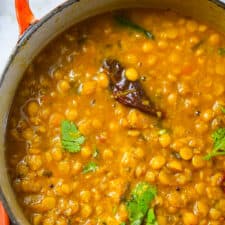
Chana Dal (Sattvic vegan Bengal Gram curry)
Ingredients
Dal:
- 2 cups chana dal dry split Bengal gram
- 4 teaspoons cooking oil canola oil, sunflower oil, or peanut oil
- 1 cup diced tomatoes
- 1 ½ teaspoons grated fresh ginger
- 2 green chilies hari mirch, chopped
- 1 teaspoon cumin seeds
- 2 dried red chilies Byadagi chilies, arbol chilies, or other
- ½ teaspoon asafetida hing
- ½ teaspoon turmeric powder
- 1 teaspoon amchur mango powder
- 3 Tablespoons chopped fresh or dried fenugreek leaves kasuri methi
- ⅓ cup chopped cilantro leaves
- 5 ¼ cup water
- 1 ¼ teaspoon salt or to taste
Tadka:
- 3 tablespoons refined coconut oil
- ½ teaspoon mustard seeds
- ½ teaspoon Kashmiri red chili powder
- 12 curry leaves
- ½ teaspoon kala namak
Garnish:
- Cilantro leaves
- Thinly sliced fresh red or green chilies
Instructions
- Rinse the chana dal thoroughly under running water until the water runs clear.
- In a large pot, heat the oil over medium-high heat.
- When the oil is hot, stir in the tomatoes, ginger, chilies, cumin seeds, dried chilies, asafetida, turmeric, and amchur. Cook for 3-4 minutes until the tomatoes start to break down and the spices become fragrant.
- Add the rinsed chana dal, methi, cilantro, and water. Bring it to a boil over high heat. Once boiling, return to medium heat, and cook covered for 50-60 minutes, until the dal is tender.
- In the meantime, prepare the tadka (tempering). In a separate small pan, heat the coconut oil over medium heat. Add the mustard seeds. Sauté until the seeds start to sizzle, pop, and release their aroma.
- Lower the heat and add the chili powder, curry leaves, and black salt. Stir-fry the spices for a minute or until fragrant. Turn off the heat and set the tadka aside.
- After the dal has cooked for 50-60 minutes and is tender but not completely mushy, add salt to the dal and continue cooking with the pot covered, stirring occasionally, another 15-20 minutes until the dal is falling apart just a little bit. Add water if the dal is looking too thick for your taste.
- Once the chana dal is cooked to your desired doneness, pour the prepared tadka over it and gently stir to combine, allowing the flavors to meld together.
- Serve in attractive serving dishes and garnish with cilantro, and if desired freshly sliced red or green chilies.
Notes
- You can easily adapt this recipe to an Instant Pot or pressure cooker. Follow steps 1-3 in the main recipe. After adding all remaining dal ingredients, including the rinsed chana dal, cook on high pressure for 12-15 minutes, depending on your device's settings, and let the pressure release naturally.
- Proceed with steps for the tadka, salting the dal, and garnish. The result will be an equally delightful Chana Dal in a fraction of the time!
- Optionally add a teaspoon garam masala or 1 tablespoon dry fenugreek leaves if you would like to easily alter the flavor of the dal.

Enter your email & I'll send it to your inbox. Plus, get great new recipes from me every week!
By submitting this form, you consent to receive emails from Cinnamon Snail.

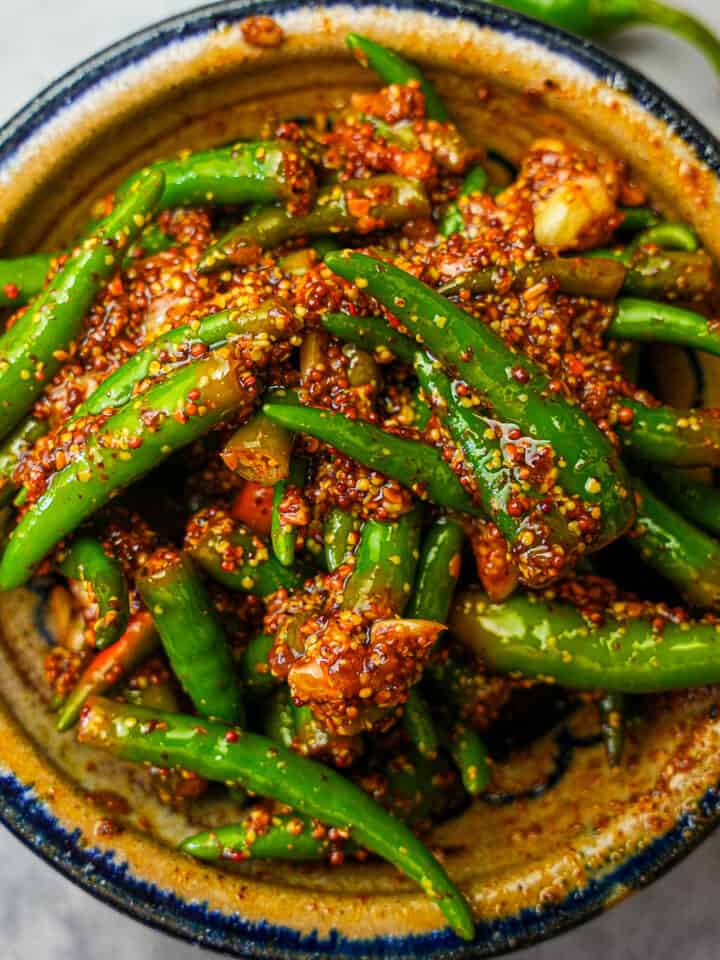
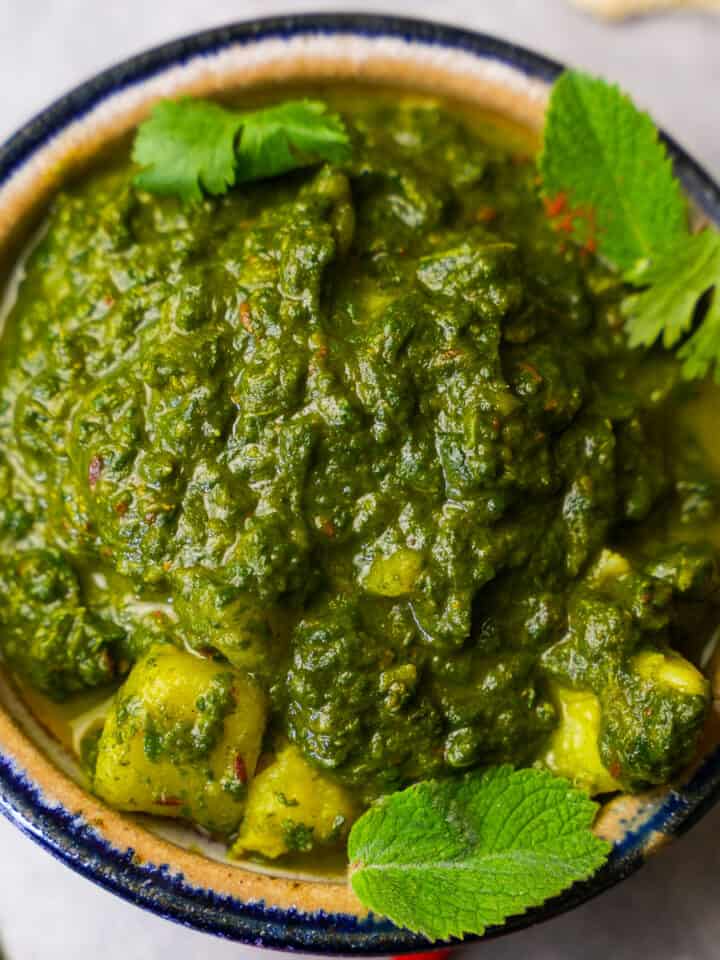
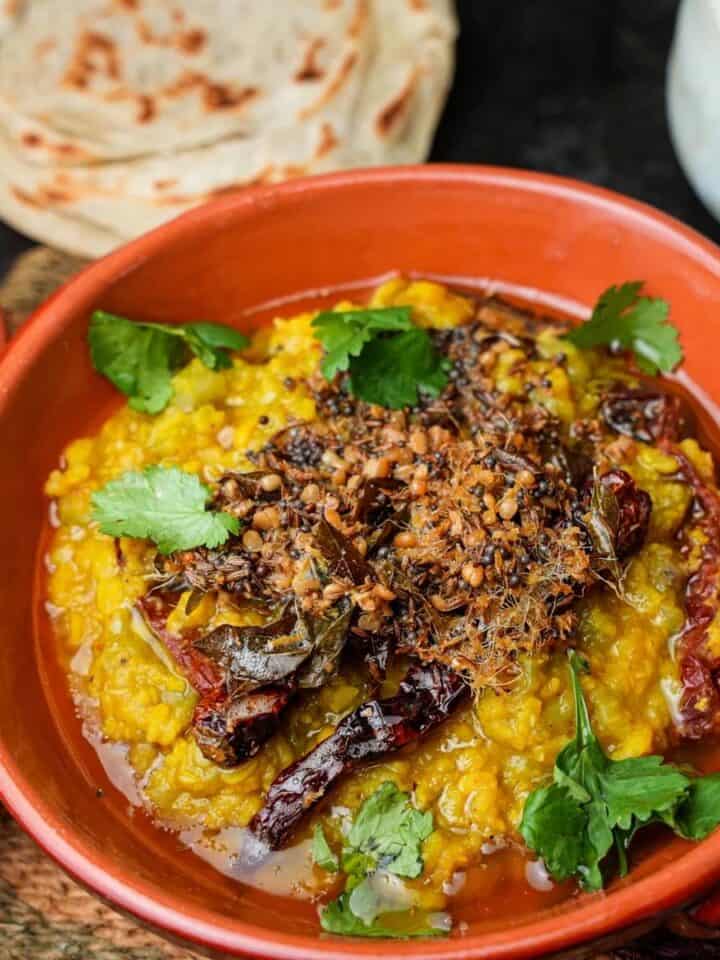







Meg says
And yes, Chef Adam…..I was definitely captivated by “each aromatic spoonful”. A great recipe.
Meg says
This dal is like the savoury version of nectar of the gods. It is completely delish and so so simple.
Daisy says
**forgot to rate it! Definitely 5 stars!
Daisy says
Delicious! Looking forward to enjoying this every day for my meal plan this week. Just the right amount of spice, and it took about 25 minutes on my stove top pressure cooker.